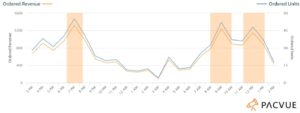
Melissa Burdick, president, Pacvue
Amazon Advertising is built on an auction system. Vendors and sellers compete for a number of different ad placements by bidding for keywords and setting a max daily budget. Unless manually paused and un-paused, every campaign begins at midnight—but what if they didn’t have to? Running campaigns 24 hours a day can be expensive and may not be very effective (for reasons we’ll get into below), but fortunately there is an alternative: dayparting.
Dayparting refers to splitting up the day into component parts so that advertisers can adjust their campaigns depending on the time of day – either scheduling their campaign to turn off and on at certain times or increasing/decreasing their keyword bid according to peak/off-peak periods. Amazon doesn’t offer this functionality in the Advertising Console so it either has to be done manually (a time-consuming process) or a third-party tool needs to be used.
Digital marketers are likely already familiar with dayparting, commonly used in SEM (search engine marketing), but now that Amazon vendors and sellers can get access to this tool, it opens up a new way for brands to optimize their marketing budgets and target shoppers where and when it counts.
Why is it Important?
The majority of advertisers on Amazon don’t use dayparting. Each campaign has a max daily budget and a CPC (cost-per-click) bid set per keyword. Without a tool to change it, the bids are set—whatever the bid is at 11:59pm today, that’s what it will be at 12:01am tomorrow.
This means that first thing in the morning when everybody’s daily budgets are reset, there’s a mad rush to win the keyword auction. We call this the CPC bid rush. When most ad managers are still sleeping and can’t adjust bids manually, ad spend is driven by the early morning Amazon crowd, which tends to produce far fewer conversions than the peak lunch and evening hours.
Advertisers are spending too much of their marketing budget on trying to place ads in the middle of the night and early morning. It’s common for this expense to cause budgets to run out between 4 a.m. and 7 a.m., leaving those advertisers unable to participate for the rest of the day.
Amazon’s priority is to give the shopper a good experience and the most relevant search results. Product pages are scored on content quality and relevance to the keyword in question—though Amazon doesn’t divulge exactly how this is measured—and this is calculated against the keyword bid, i.e., how much the vendor is willing to pay. Multiple ad placements are up for grabs and Amazon’s algorithm decides who wins what.
Because most campaigns don’t use dayparting, competition tends to decrease over the course of a day as more and more campaigns hit their budgets. This means the CPC also tends to fall throughout the day, even though Amazon’s conversion rates can peak during the after dinner hours.

Effective optimization is all about tailoring campaigns toward consumer behavior and dayparting is another lever to pull. It allows advertisers to reduce or eliminate their bids during the high competition, low conversion early morning hours and conserve that budget for the more efficient midday and evening hours.
Dayparting Best Practices
- Go dark during the CPC bid rush. If you’re trying dayparting for the first time, begin by avoiding the CPC bid rush entirely. Test the effects of pausing a campaign from midnight to 6a.m.—the results can be dramatic. For example, one major power tool brand drove a 32% decrease in spend and a 34% increase in ROAS [return on ad spend] with this one simple change.
- Track performance by day of week. Peak times vary by category and dayparting allows you to target your campaigns based on time of day as well as day of week. Monitor your sales history and identify which days of week tend to experience the highest conversion and make those days a priority for your advertising budget.
- Align with lightning deals. Amazon lightning deals are popular and effective promotions which run for a short period of time. Using dayparting, you can increase the visibility of your promotions with a focused keyword boost, rather than spending a whole day’s budget on it.
- Use ARA Premium. If you have a premium subscription to Amazon Retail Analytics Reporting, you have access to a detailed breakdown by day of week and hour of performance for your products. This takes into account the entire flywheel, including organic and paid results, so it gives you the most complete picture of performance. These analytics can give you great insight into the behavior of your customers and how to optimize your dayparting.
- Test and learn. Most importantly, run tests! No two brands have exactly the same audience and effective optimization requires testing numerous tactics and identifying what does and doesn’t work. For example, a personal security brand performed an A/B test with two identical campaigns except that one began at 8 a.m. daily and the other didn’t begin until 6 p.m. daily. The former resulted in an ACOS (advertising cost of spend) of 20.4% while the latter 15.5%. They learned that, for this particular product, focusing exclusively on the evening hours increased campaign efficiency significantly.
Amazon advertising is an investment. It can be hard to justify if your products are doing well organically. But it’s never a bad investment to allocate a percentage of your budget, even as little as 5%, to testing and learning.
To properly measure the effectiveness of each test, you need to identify which KPIs are important to you. For example, by going dark in the morning your impressions will fall, so if impressions are your key KPI, this may look like a loss. But CPC will also fall and conversion rate will likely increase. If you remove the junk impressions and focus on generating impressions and clicks that have a higher chance of converting, you’re going to spend less and get the same, if not better, return.
Dayparting is just another lever to pull in order to optimize your marketing campaigns and improve ROAS. Do more with a limited budget, be more aggressive during peak hours, boost your visibility during Deal Days and promos and align your ad spend with the behavior of your customers.
Pacvue provides a software-as-a-service platform that enables brands, sellers and agencies to programmatically manage and optimize their advertising on Amazon.
Favorite